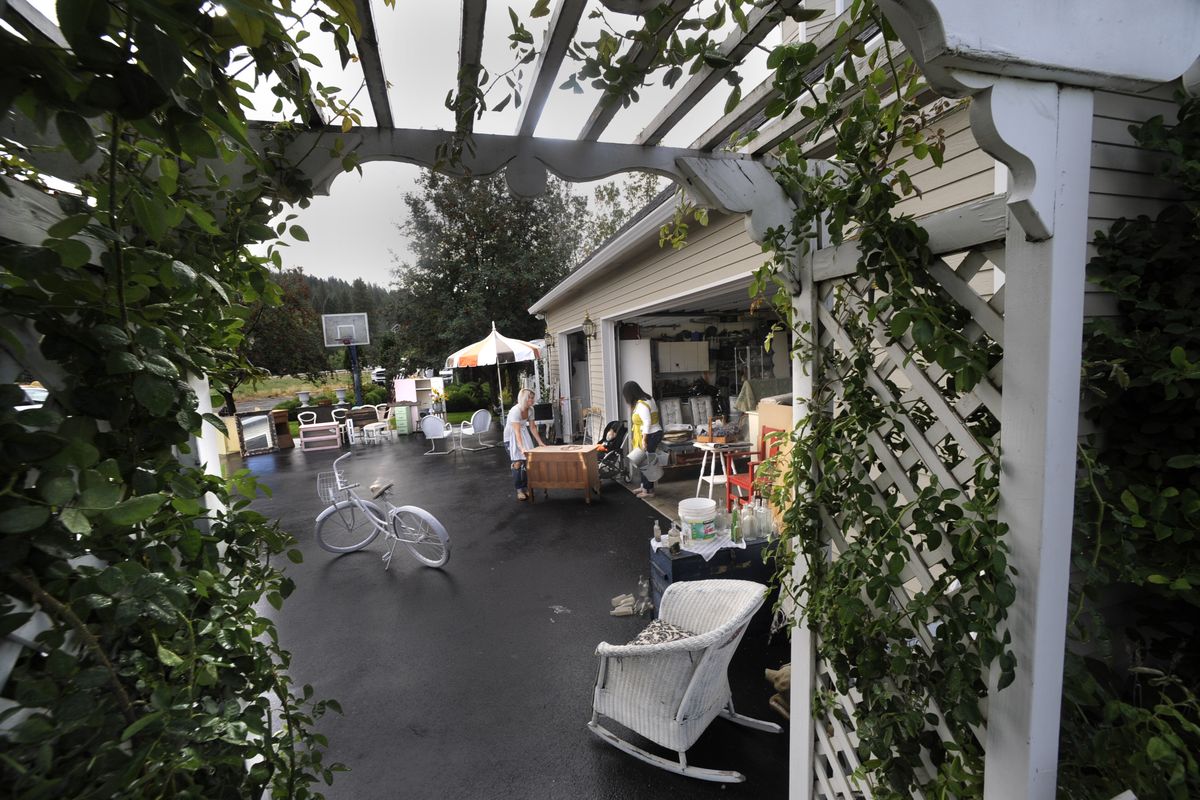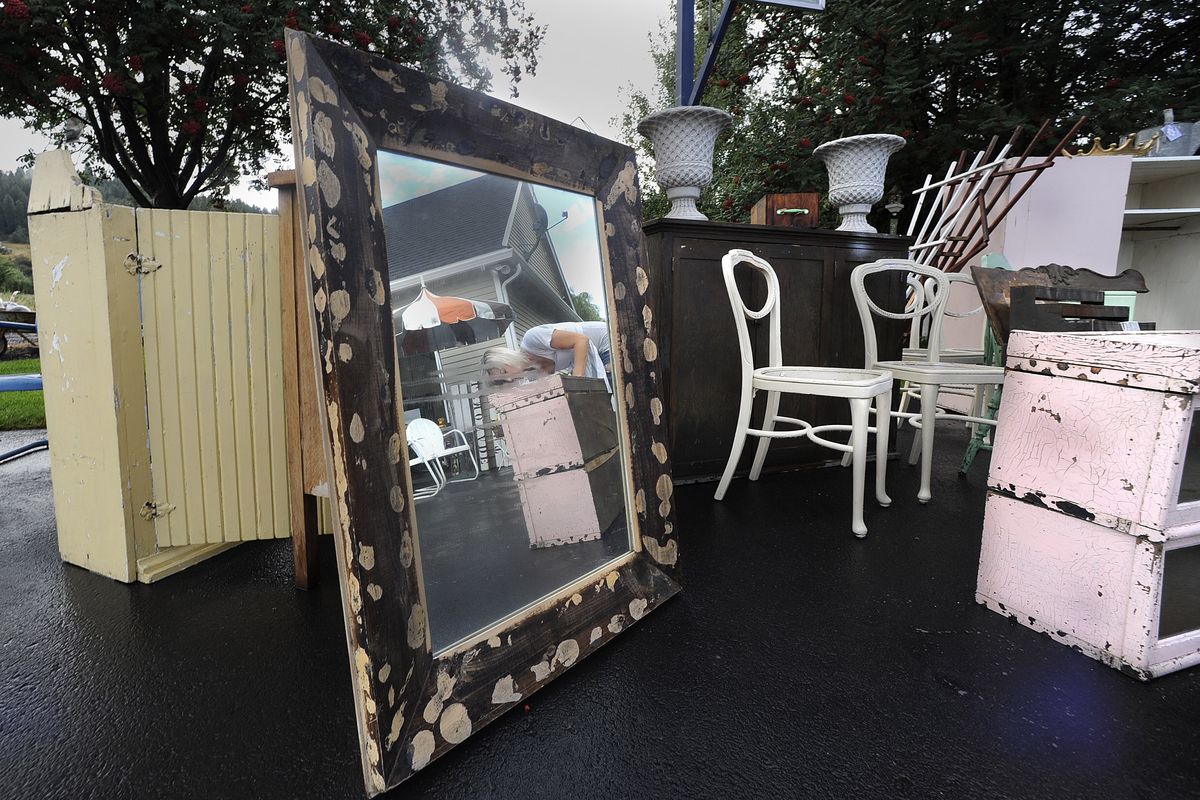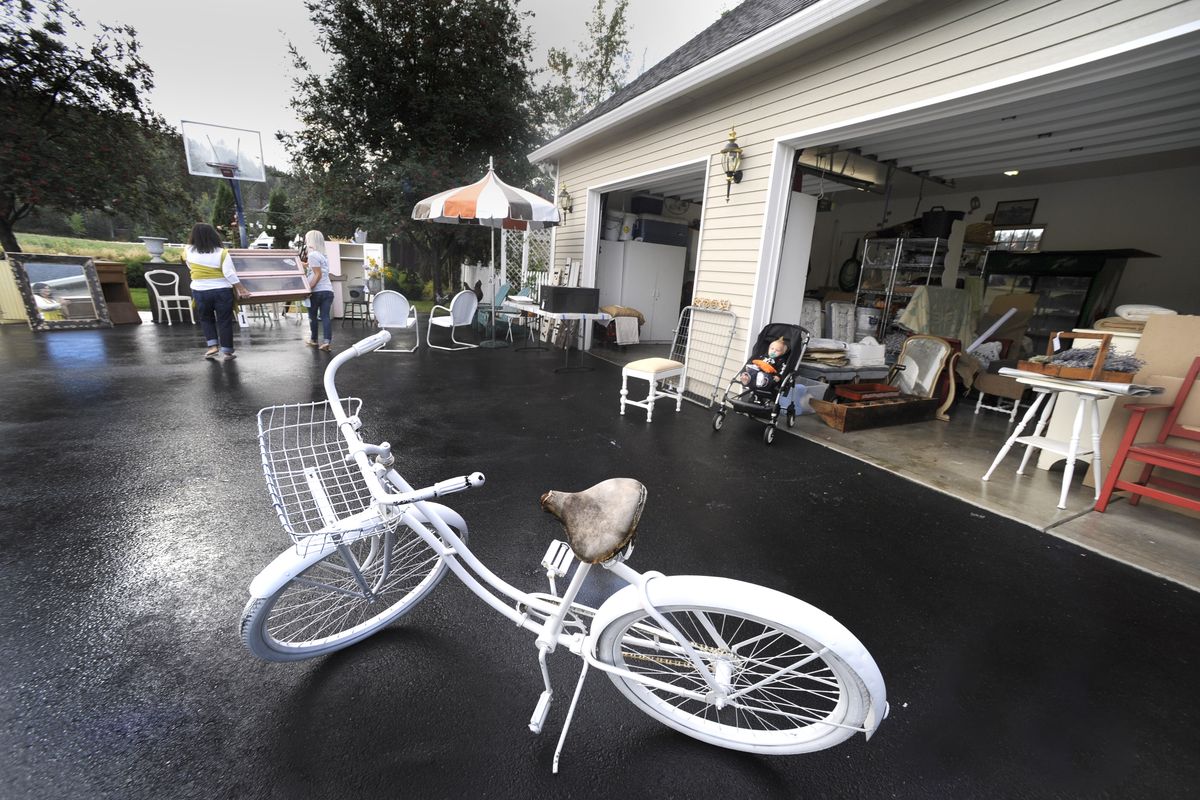Show shoppers
Events such as the Mad Hatter market offer a different kind of shopping experience
Gladys and Celia Hanning prepare for their Mad Hatter Vintage Flea Market by moving items out of the garage. (CHRISTOPHER ANDERSON / The Spokesman-Review)
There are two kinds of shopping.
There’s the shopping you do when you need something – a tube of toothpaste, a jar of pickles, whatever – and you could care less whether the store that carries it looks like a warehouse or a wonderland.
Then there’s the shopping you do for the experience of shopping. That’s when the products are displayed and the store is decorated in such a way that you’re inspired by your surroundings.
For the past few months, Gladys and Celia Hanning have been working night and day to create the latter for the shoppers they hope will attend their first Mad Hatter Vintage Flea Market next Friday and Saturday at Five Mile Prairie Grange.
They created fliers with charming images of “Alice in Wonderland’s” Mad Hatter. On the Grange’s stage, they plan to set tables for a make-believe tea party under a tree decorated with antique medicine bottles. And they’ve asked their 17 vendors to don whimsical costumes.
“I want people to walk in and say, ‘Oh, my gosh,’ ” Celia Hanning says. “I want it to be eye candy.”
The Mad Hatter Market comes after a summer filled with funky, junky vintage sales and craft fairs in the Spokane area.
Between June and September, bargain hunters and antique lovers enjoyed the Farm Chicks Antique Show, the Latah Creek Variety Market, MaryJanesFarm Farm Fair, two installments of the Two Women Barn Bazaar and two installments of the Vintage Barn Antique Show, among others.
The Mad Hatter also comes at the dawn of the holiday craft fair season, and on the same weekend as Jim Custer Enterprises’ big fall Antique & Collectors Sale at the Spokane County Fair and Expo Center.
“I think we’ll draw a different audience, a younger audience,” says Gladys Hanning, who is Celia’s mother.
The Hannings own Junebug Furniture & Design, a home-furnishings, décor and interior decorating company, which they run out of Gladys’ home in Mead.
In the past, Gladys operated two brick-and-mortar stores in Spokane: Junebug on North Division Street in the early 2000s, and Wilderness Creek Collection in the Riverwalk Complex at Trent Avenue and Hamilton Street in the late 1990s.
When Junebug closed in 2001, Gladys’ clearance sale drew customers she’d never seen before.
“People came in for the 50 percent off and said, ‘You can’t close. I love this,’ ” she says. “And I thought, ‘Where were you?’ ”
Soon after, the Farm Chicks started holding their popular antique shows, and the others have followed on a smaller scale. Gladys became an antique show vendor rather than pursuing another storefront.
The format for the shows is simple: The venue is usually a barn, city park, grange hall or, in the case of the Farm Chicks, the fairgrounds. The vendors pay the organizers a fee to participate and then set up their booths, displaying merchandise they’ve collected by scouring estate sales and secondhand stores.
Beyond the basic equation, the shows require a lot of work on the part of both the organizers and vendors. Gladys says about half of the goods they find don’t need tinkering, but the rest get either a fresh coat of paint or new upholstery.
“We’ve been using burlap sacks to upholster lately,” she said in her garage, pointing to a re-covered bench awaiting the Mad Hatter Market.
And, like any retailer, vendors have to shell out cash for items they’re not positive will sell.
“A lot of the time, I have to remind myself to buy not just what I love, but what other people like, too,” Celia says.
More and more, vendors also are selling handcrafted items, such as aprons made from vintage fabrics or throw pillows sewn from old linens. The prices usually reflect the time that goes into making them, but that can cause sticker shock for shoppers who are more accustomed to discount-store rates.
And when it comes to display, forget about just draping a sheet over a plastic table. Vendors at these shows hang handcrafted chandeliers, erect miniature barns or set up mock bedrooms or dining areas to inspire and attract customers.
The Hannings sometimes do a practice run in Gladys’ driveway of how they want their booth to look.
The shows last a day or two and can draw thousands of shoppers. The vendors usually turn a good profit, but not always, Gladys says.
“We’ve had some good shows, and we’ve had some bad ones,” she says, recalling a time she paid a $300 vendor fee but only made $300 in sales.
Celia makes enough that she can stay home with her three children, though she also provides child care for her sister and does housecleaning on the side.
Gladys began dreaming of running her own show after attending the Farm Chicks’ first sale in 2002.
“I remember thinking, ‘I can do this,’ but it took me a while to figure out how to make mine different,” she says.
She has come to the conclusion that the shows – rather than traditional shops that sometimes are located miles apart – are the way to go.
“With a show, it’s like walking into 17 different little shops,” Gladys says.
Dianna Chelf, who runs the Two Women Barn Bazaar with her daughter, Fielding, sees it the same way.
She limits her shows to 38 vendors to keep the event “small and comfortable.”
“I want everyone to have a chance to make some money,” she says. “There are only so many slices of pie to go around.”
Part of the fun of the events is for vendors to buy from one another, Chelf says.
“There’s one vendor – oh, man – when she starts unpacking, zoom, I’m out there,” she says.
Chelf always loved treasure hunting, especially at the “swap meets” in Tucson, Ariz., where she raised Fielding.
“We called the style of our house ‘Early Swap Meet,’ ” she says.
She found the best items during trips to visit her mother-in-law in Michigan. They’d stop at farmhouses, ask the homeowners if they needed to get rid of any junk in their barns, then load up their truck.
“One time I asked a woman how much she wanted for the truckload and she said, ‘I don’t know. Is $5 too much?’ ” Chelf recalls. “We gave her $200.”
While digging through a barn another time, she opened up a box full of mice and was so startled she flung it in the air.
“It was so much fun,” Chelf says. “You’d open up the barn doors, and it was like Christmas.”
She says vintage treasures are becoming harder to find, and that’s why sales that bring several vendors together – like the one she and her daughter hold on their property just south of Spokane – make it easier for everyone.
Gladys and Celia Hanning’s goal is to hold their show at Five Mile Prairie Grange for a couple of years and then move it to the property surrounding Celia’s house in Mead.
That sure would make their commute easier.
Two weeks ago, Gladys’ garage was packed with items tagged and ready to sell, including “Dolly Dingles” paper dolls from the 1920s, an aqua-colored wheelbarrow and a well-worn cabinet from a roller skating rink, its pink paint chipped.
Celia held up the rusty skeleton of an old mattress and wondered aloud whether they’d have time to turn it into some sort of art piece before the show.
“We just love the junk,” Gladys said.


